Vision and Creativity
by Michael Frye | Apr 30, 2018 | Vision and Creativity, Workshops
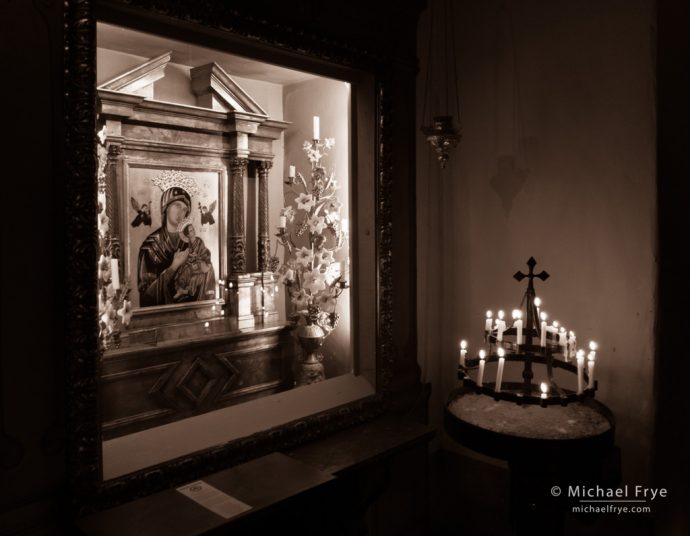
Carmel Mission, Carmel-by-the-Sea, California. Even when a church or museum allows photography (as was the case here), a smartphone camera is less obtrusive than a big SLR.
Last month Claudia and I went to Carmel to assist our good friend Robert Eckhardt’s iPhone photography workshop. Robert is a highly creative photographer, a great instructor, and knows more about iPhone photography than anyone I’ve ever met. This is the second time we’ve done this workshop, and both editions have been really fun. Everyone (including me) learned a lot, and we had a great time photographing around Carmel and processing the images right on our phones.
Participating in this workshop made me reflect on how much smartphone photography has progressed in just a few years. Smartphone cameras have gone from novelty items to highly-capable devices, and a plethora of apps allow you to do just about anything imaginable to the photographs you take on your phone. (And some things that you would never imagine until someone makes an app for it.)
(more…)
by Michael Frye | Dec 28, 2016 | Vision and Creativity
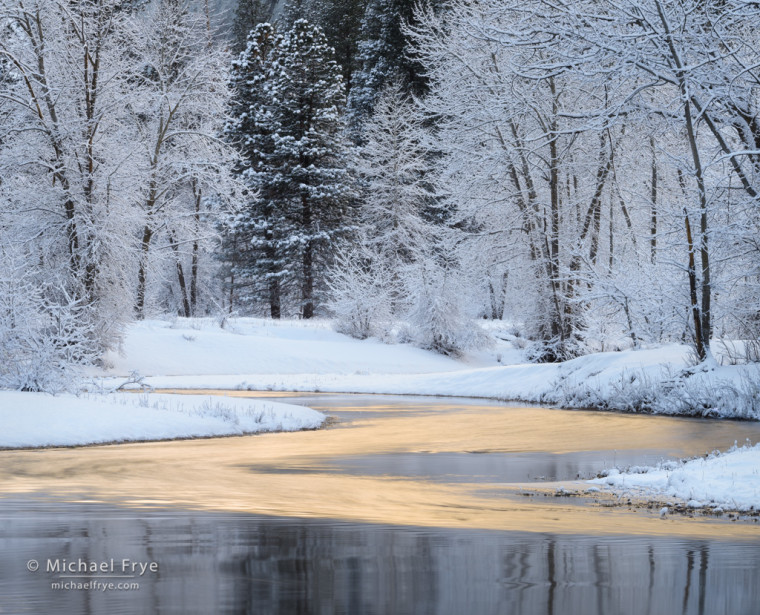
Reflections along the Merced River, winter, Yosemite NP, CA, USA
It’s become a tradition on this blog to ask my readers to help pick my best images of the year, so on January 1st I’ll be posting the nominees for 2016 and asking all of you to vote for your favorites. It’s always fun to see what people pick!
Last year readers voted this snow scene into the top ten. It actually got the fifth-most votes, which was a pleasant surprise for an intimate landscape like this. (You can see last year’s nominees here, and the top ten here.)
(more…)
by Michael Frye | Nov 6, 2016 | Composition, Vision and Creativity
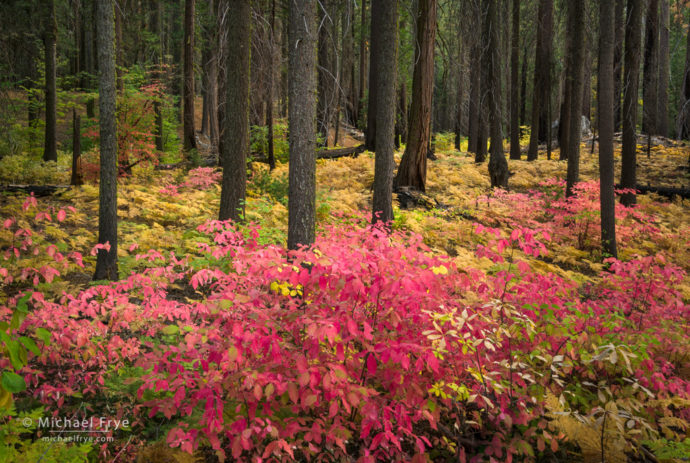
Autumn forest with dogwoods and ferns, Yosemite, October 13th. I stood on a log to see over the foreground dogwoods and into the forest; the focal length was 35mm.
I’ve made many images of intimate landscapes over the years, and the vast majority of them were taken with a telephoto lens (usually my 70-200mm zoom). It makes sense to use a lens with a narrower angle of view when focusing on a small piece of the landscape and trying to eliminate clutter in complex forest scenes. Telephoto lenses are also great for compressing space and emphasizing patterns – typically key components of intimate landscapes.
But lately I’ve found myself using wide-angle lenses more and more for smaller scenes. Part of the impetus for this was just buying a new lens. This past July I purchased a new wide-angle zoom (the Sony Vario-Tessar FE 16-35mm f/4 ZA OSS), and it’s natural to want to use and test a new piece of equipment, so I started pulling this lens out in many situations just to see what it could do. But another part of the impetus was just the desire to do something different. I’ve had plenty of practice composing intimate landscapes with telephoto lenses, and I wanted to force myself to look at these scenes in a new way.
(more…)
by Michael Frye | Oct 9, 2016 | Vision and Creativity
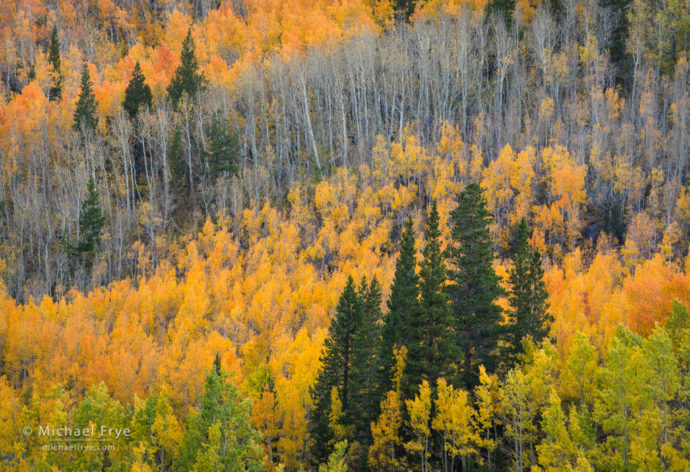
Aspen-covered hillside, Bishop Creek Canyon
During our recent trip to the eastern Sierra I hiked up a trail I’d never been on before. I hoped the trail might lead to view overlooking a hillside full of aspens. It didn’t – at least not directly. I had to leave the trail and work my way out on some rock outcrops, where I did finally reach a spot with a view of that aspen-covered hillside, and made the photograph above.
I was pretty happy with that image; I liked the curving line of bare trunks, and the way the clumps of pines in the lower-right and upper-left corners played off each other. But my eyes kept getting pulled to some aspens next to the rock outcrop. The leaves on these trees displayed a wonderful kaleidoscope of hues – yellow, orange, red, green, even a bit of maroon. I realized that these aspens right in front of me had at least as much photographic potential as the ones on the distant hillside.
(more…)
by Michael Frye | Aug 21, 2016 | Composition, Vision and Creativity
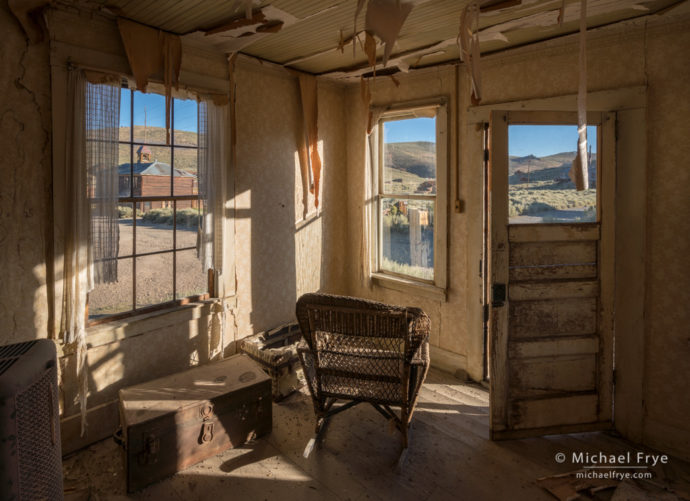
McMillan House interior, Bodie State Historic Park, California. The high contrast of this scene required using Lightroom’s HDR Merge. Also, I deliberately avoided having sunlit areas touch the borders of the image. A bright spot along the edge would pull the viewer’s eye out of the photograph.
As I’ve explored this place, I’ve realized that I’m not as interested in the abandoned mining equipment and machinery, as fascinating as some of those things are. I’m drawn more to the places where people once ate and slept and drank and socialized, and left behind the artifacts of their lives – furniture, cooking utensils, books, magazines, pictures, cans, bottles, a baby carriage, a bird cage, sewing machines, coats, pants, hats, shoes…
(more…)
by Michael Frye | Mar 10, 2016 | Announcements, Vision and Creativity
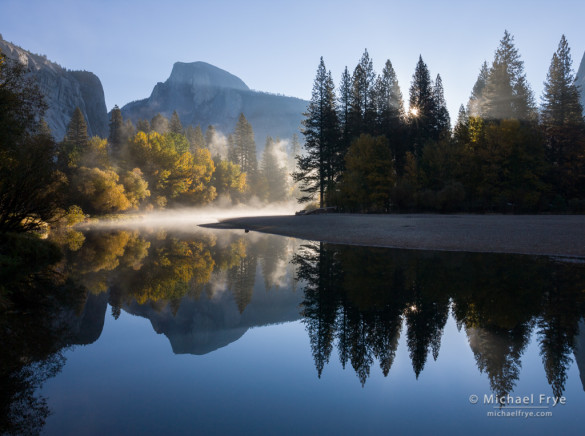
Autumn Sunrise, Half Dome and the Merced River, Yosemite – one of the examples in my latest article for Photograph magazine
We can’t control the weather. We don’t determine where trees grow, mountains form, or rivers flow. In landscape photography we have almost no control over our subjects, so we have to adjust to the conditions at hand.
Craft & Vision just released Issue 15 of Photograph magazine, which includes my piece called “The Art of Being Flexible.” I think flexibility is an essential skill for landscape photographers. Since we have so little control over our subjects, we have to be willing and able to react to changing weather and conditions, and try to take advantage of whatever opportunities present themselves, even if those opportunities weren’t what we expected. The article discusses this subject in depth, and includes several examples showing how to anticipate the weather and light, recognize possibilities, and take advantage of the opportunities you’re given.
(more…)














